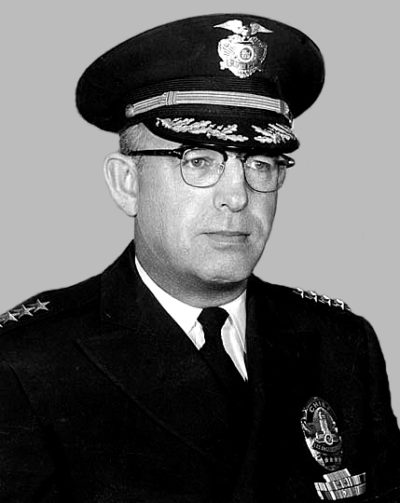William Parker (William H. Parker)

William Parker was born in Lead, South Dakota, and raised in Deadwood. His grandfather William H. Parker (1847-1908), was an American Civil War veteran who later served in Congress. The Parker family migrated to Los Angeles, California, in 1922, for better opportunities, when the city was advertised as the “white spot of America” during that period. Parker originally wanted to be an attorney, and studied at several colleges before enrolling in 1926 at the University of the West’s Los Angeles College of Law, an institution which operated in the 1920s and 30s. He joined the Los Angeles Police Department on August 8, 1927, and continued his legal studies. Parker graduated with an LL.B. degree in 1930 and passed the bar exam, but opted to continue with the police department instead of practicing law. He served as an LAPD officer for 15 years before taking a leave to fight in World War II. He attained the rank of captain as a planner and organizer of prisoner detention and policing in Sardinia, Normandy, Munich, and Frankfurt. Parker received the Purple Heart after being wounded during the Normandy invasion. His other awards included the French Croix de Guerre with silver star and the Order of the Star of Italian Solidarity. After the war Parker returned to the police department and rose through the ranks to captain, then inspector, and then one of the department’s deputy chiefs.
William Parker became police chief on August 9, 1950, and is credited with transforming the LAPD into a world-renowned law enforcement agency. The department that he took over in 1950 was notoriously corrupt. Seeing the old ward peacekeeping politics, with its heavy involvement by partisan groups in the police department and commingling of political circles with vice and corruption on the streets, led him to conclude that a different organized police force was necessary to keep the peace. William Parker’s experience with military public relations in World War II was used to develop an effective media relations strategy for the police department. Thanks to shows such as Dragnet and a steady stream of good publicity from local newspapers, he was highly admired nationwide. Parker was a guest on the television program What’s My Line? on August 21, 1955. Under Parker’s early term, the Los Angeles Police Department initiated a more professionalized force which institutionalized officers into an environment that was more answerable to administrative oversight than political representatives. Included in this change was a standardized police academy, more proactive policing methods, practices very similar to military peacekeeping methods to which he was exposed during the war. Under William Parker, the LAPD faced accusations of police brutality and racial animosity towards the city’s African American and Latino residents. Parker allegedly supported the city’s racist power structure, which he denied as late as the 1960s. Some critics see Parker as responsible for ongoing tensions between the LAPD and minorities. However, Parker was the chief who desegregated the police force as the Civil Rights Movement rose.
Another aspect of changes initiated by William Parker which changed the police force from one of a walking peace-force to a more militarized mobile response force, was a reduction in the size of the police force, in relation to the population. The term “Thin Blue Line” was coined by Parker. Parker’s experience with the numerically larger force of his early career led him to judge that fewer but more professional officers would mean less corruption. Additionally, the strategy of changing the beat posture to one of mobility led to change from foot patrols to one which favored police cars. Not incidentally, this also furthered Parker’s belief that isolating his officers from the streets would reduce opportunities for corruption. However, Parker recognized that certain areas of the city and certain functions of the police department needed to remain rooted in the more traditional form of police work. Although Parker reduced police corruption and cleaned up the overall image of the police, certain sections of the police continued practices which lent more to an image of old semi-corrupt control of vice and petty crime. The vice squad and reserve force continued to remain controversial elements of the police force. William Parker also used elements of the reserve force such as the Organized Crime and Intelligence Division of the LAPD to keep tabs on suspected politicians and their mafia syndicate allies as well as the notoriously corrupt and narcotic ridden Hollywood movie industry system and its celebrities. The 1990 novel and 1997 film L.A. Confidential along with the 2013 film Gangster Squad provide fictional depictions of the LAPD under Parker during these years.
William Parker served on the Los Angeles County Civil Defense and Disaster Commission during the Cuban missile crisis in the early 1960s. William Parker died of a fatal heart attack on July 16, 1966, after attending a dinner where he received a commendation. The LAPD’s Police Administration Building on North Los Angeles Street was officially renamed Parker Center shortly after his death.
Born
- June, 21, 1905
- USA
- Lead, South Dakota
Died
- July, 16, 1966
- USA
- Los Angeles, California
Cause of Death
- heart attack
Cemetery
- San Fernando Mission Cemetery
- Mission Hills, California
- USA



